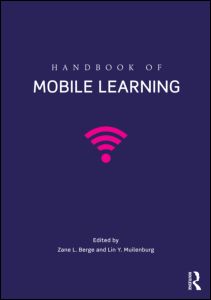Book Review: The Handbook of Mobile Learning By Zane L. Berge, and Lin Y. Muilenburg
Berge, Z. L., and Muilenburg, L. (2013). Handbook of mobile learning. New York, NY: Routledge.
Reviewed by Dr. Farhad (Fred) Saba
Founder, Distance-Educator.com
For further information and ordering this book go the the publisher’s website.
One of the most promising and exciting technologies that has emerged in the last decade is mobile learning. With the ubiquity of wireless communication, smart phones and tablets mobile learning is no longer an experimental mode of education. Major educational institutions are committed to it throughout the world with profound theoretical and practical effects on them. This innovative use of wireless communication and mobile devices for learning has re-opened the discussion of the role of formal education in relation to self-directed informal learning when the opportunity to learn is constantly available in the palm of the hand of the learner.
Although there has been a plethora of articles, position papers and reports published on the subject, the Handbook of Mobile Learning is unique in that it has brought together the current knowledge base of the field in one convenient volume. The Handbook offers a wealth of theoretical and practical information to those who have already embarked upon mobile learning projects, as well, as those who are currently considering implementing a program.
Dr. Zane Berge, the lead editor of the Handbook, has decades of experience in the field of distance education and application of innovative forms of learning in business, industry, higher education and K-12 schools. Dr. Berge, and his co-editor Dr. Lin Muilenburg, have succeeded in bringing together a stellar international group of authors for contributing to this book. The global reach of mobile learning and the variety of settings for its application in different organizations are well presented and discussed in this extensive volume of 638 pages!
The Handbook of Mobile Learning is unique in that it has brought together the current knowledge-base of the field in one convenient volume.
In reading the Handbook what impressed me at the outset was the depth and breadth of the theoretical and conceptual treatment of the subject. A discussion of the history of mobile learning in the first chapter of the Handbook connects the practice of mLearning to different models in learning design as well as historical developments in information and communication technologies since the 1970s. But the discussion of the foundations of the field doesn’t end there. Theories of learning and communication as well as models of instructional design, based on which the practice of mobile learning has become possible, are discussed in great depth in the remaining eleven chapters of the first of part of the Handbook. Also, given the relative youth of the field, several authors in this section have presented their research and insights about the future of mobile learning; a discussion that should be very useful for educational institutions that are planning to implement mobile learning projects in the years to come.
However discussion of the historical, theoretical and developmental aspects of the subject is not limited to the first part of the Handbook only. Analytical treatment of these facets of mLeaning has permeated throughout the entire volume. The reader is treated to a rich and multifaceted examination of the current status and future prospects of mobile learning throughout all five parts of the book. Such in-depth analyses are usually lacking in treatment of innovative application of technology in education during their formative phase. This volume provides a wide-ranging theoretical platform for launching new projects in mLeanirng, as well as practical knowledge about analyzing, evaluating, and reorienting ongoing projects.
The editors have given equal attention to practical aspects of introducing mobile learning to institutions as well as implementing and managing new programs. In Part IV of the Hadbook issues related to policies, administration and management were presented while Part V is focused on several case studies. These studies have been presented in detail and offer a wealth of information on the application of mLearning in specific subject areas, as well as in different organizational settings. For example, Chapter 33 in Part IV puts forward a systematic model that was used to successfully implement mobile learning application of one of the most popular learning management systems in a large state institution of higher education in the US. Also, this section gives specific attention to some of the most challenging aspects of using mobile devices in universities. Chapter 34, titled So We Had This Idea: Bring Your Own Technology at Brebeuf Jesuit presents a detailed treatment of issues ranging from availability of enough bandwidth to device management and tracking students, to student access to instructional materials stored on servers related to the school and materials that are on the rest of the Internet. These are but only two examples of many other excellent chapters on practical issues related to the use of wireless communication and hand-held devices in learning and teaching.
The reader is treated to a rich and multifaceted examination of the current status and future prospects of mobile learning throughout all five parts of the book.
Part II of the Handbook is devoted to the subject of learning and learner support, and Part III to teaching and instructional design. Authors in these two sections continue the general approach of the Handbook in keeping one foot in the theoretical realm and one in the practical to explore new territories that mLearning introduces to the general education space. By addressing the theoretical and practical issues together these authors:
- Bring to fore numerous challenges that new information and communication technologies have introduced to the idea of formal education as the possibility for self-directed learning has dramatically expanded,
- Explain the practical ramifications of these challenges to formal institutions of education and
- Describe a new learning space-time in which previous structures, such as the classroom or a set curriculum may not apply.
 For example, authors in Chapter 15, offer a three-pronged approach to developing a support system for learners who have to constantly manage their learning and other activities in a networked environment that is subject to rapid change. Their suggested approach is based on Vygotsky’s concept of scaffolding, Berg’s model of learner support, and Siemen’s connectivism. The resulting model that they have presented in this chapter is useful not only for practitioners in mLearning but any educator that is using telecommunication technologies for teaching and learning.
For example, authors in Chapter 15, offer a three-pronged approach to developing a support system for learners who have to constantly manage their learning and other activities in a networked environment that is subject to rapid change. Their suggested approach is based on Vygotsky’s concept of scaffolding, Berg’s model of learner support, and Siemen’s connectivism. The resulting model that they have presented in this chapter is useful not only for practitioners in mLearning but any educator that is using telecommunication technologies for teaching and learning.
Authors in Chapter 16 titled “A Mobile Pedagogy Approach for Transforming Learners and Faculty” perhaps provide the best example of an exploration in how the new information and communication technologies have extended the learning space-time environment beyond its traditional boundaries and have challenged educational institutions, as well as instructors and learners, to adapt to this new environment. They suggest that mobility has the potential to make learners more self-sufficient, and change their relationship with the instructor and their peers. Similarly, formal institutions must understand that learning now can take place in ad-hoc infrastructures that provide more autonomy to learners, and engage them at levels that, for example, the formal classroom lecture never could.
Within the framework of this book review it is not possible to give more examples of similar excellent chapters in the Handbook of Mobile Learning that move the discussion on all aspects of education forward. The Handbook offers many other similar outstanding chapters requiring readers to critically address:
- How education at the meta level is structured at the present time and
- How it might transform when more students gain access to powerful hand-haled devices that would liberate them to one degree or another from the highly structured learning environment of traditional education.
In short, this Handbook has seriously dealt with the subject of mobile learning and has provided the theoretical foundation as well as many practical suggestions for learning “across multiple contexts, through social, and content interactions, using personal electronic devices.” (Crompton 2013, p. 4). However, it has also opened many doors for future theoretical explorations and research studies as learners become more self-directed and independent in a highly volatile and unstructured connected environment.
For further information and ordering this book go the the publisher’s website.








